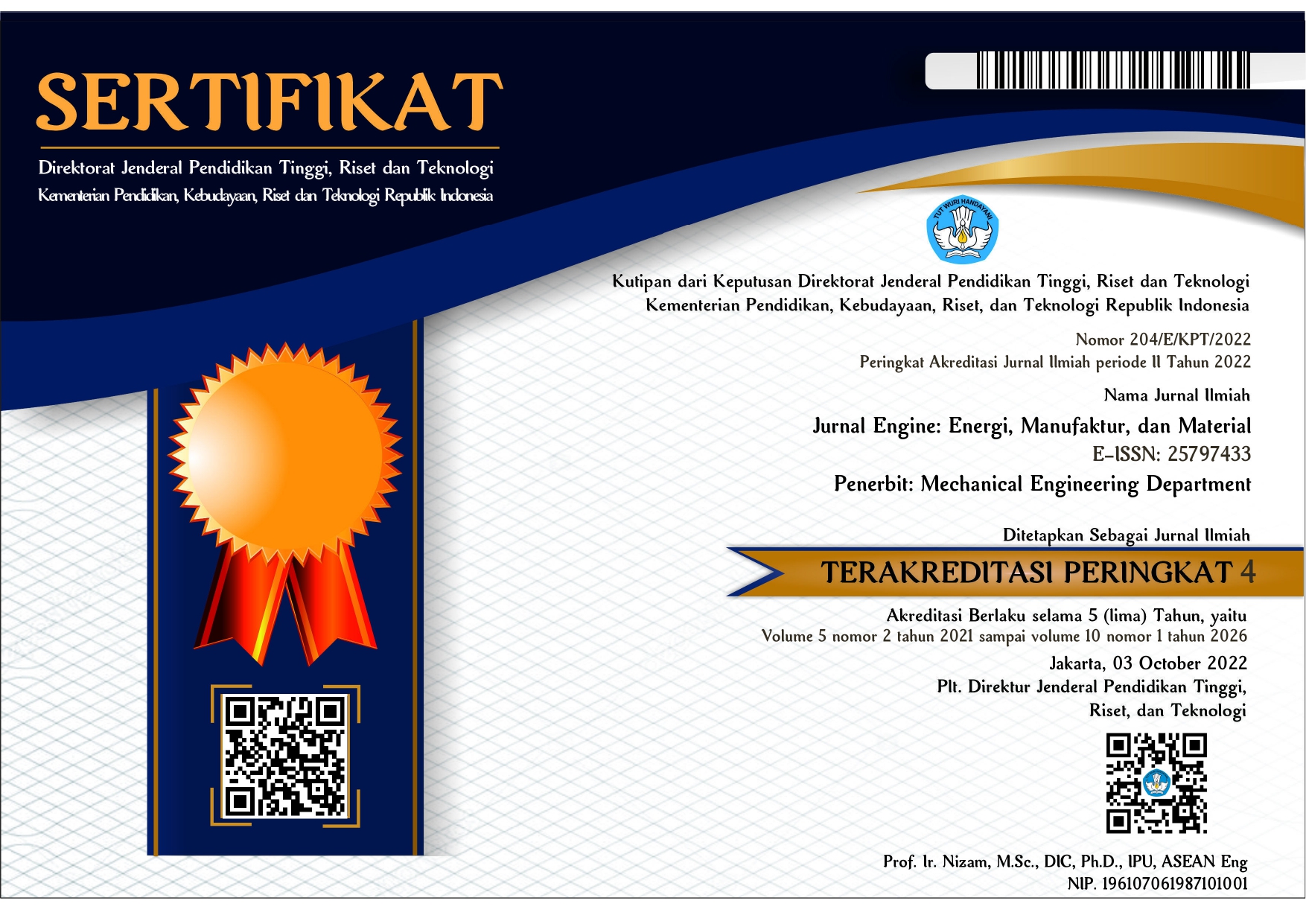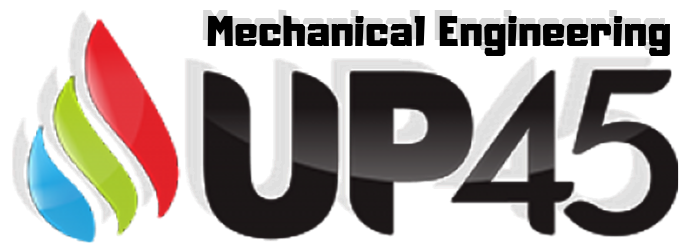Studi Eksperimental Pengaruh Variasi Sudut Kemiringan terhadap Temperatur Onset Termoakustik Generator Gelombang Berdiri dengan Panjang Resonator 780 mm
DOI:
https://doi.org/10.30588/jeemm.v2i2.418Keywords:
thermoacoustic generator, tilted angle, onset temperatureAbstract
Onset temperature is one of the most important parameters in thermoacoustic generator to be researched. In that application, onset temperature can representated how many the performance of this device, if seen by input energy, used the system of the thermoacoustic generator. Decreasing onset temperature so decreases the energy that used to generate acoustic energy in thermoacoustic generator. In this researched would be done research of variation of tilted angles -90º, 0º, dan 90º with constant 780 mm of resonator length. The method used two thermocouples installed between the stack side to measure temperature of HHX and CHX, and the ΔT called onset temperature. It would be found the effective tilted angle that used, so the performance is on the best value represented by the least onset temperature. The result is when the tilted angle decrease so the onset temperature became decreased too. In this research, if seen by the input energy, the best performance of thermoacoustic generator is on -90º of tilted angle.
References
Arafa, N. M., Ibrahim, A. H., Addas, K. & Abdel-Rahman, E. (2011). Design Considerations for Thermoacoustic Engines for Low Onset Temperature and Efficient Operation. Forum Acusticum 2011, Aalborg, Denmark.
Hariharan, N. M., Sivashanmugam, P., & Kasthurirengan, S. (2012). Influence of stack geometry and resonator length on the performance of thermoacoustic engine. Applied Acoustics, Vol. 73, 1052-1058. https://doi.org/10.1016/j.apacoust.2012.05.003
Hatazawa M., Sugita, H., Ogawa, T., & Seo, Y. (2004). Performance of a thermoacoustic sound wave generator driven with waste heat of automobile gasoline engine. Transactions of the Japan. Society of Mechanical Engineering, Vol. 70, 292-299.
He, Y. L., Ke, H. B., Cui, F. Q., & Tao, W. Q. (2013). Explanation on the onset and damping behaviors in a standing-wave thermoacoustic engine. Applied Thermal Engineering Vol. 58(1-2), 298-304. https://doi.org/10.1016/j.applthermaleng.2013.04.031.
Murti, P., (2015). Studi Eksperimental Pengaruh Jejari Hidrolik dn Panjang Stack Terhadap Kinerja Prime Mover Termoakustik Gelombang Berdiri. Yogyakarta: Tesis, Jurusan Teknik Mesin dan Industri, Universitas Gadjah Mada.
Pan, N., Wang, S., & Shen, C. (2014). A fundamental study on characteristic of thermoacoustic engine with different tilt angles. International Journal of Heat and Mass Transfer, Vol. 74, 228-237. https://doi.org/10.1016/j.ijheatmasstransfer.2014.03.019.
Setiawan, I., Utomo, A. B. S., Maruto, G, & Andi, R. W. (2005). Rancang Bangun Piranti Termoakustik Sebagai Pendingin dan Pemanas Secara Simultan. Yogyakarta: Laporan Penelitian Antar Bidang Ilmu, Proyek Penelitian Antar Bidang Ilmu, FMIPA Universitas Gadjah Mada.
Setiawan, I., Masafumi, K., & Makoto, N. (2013). Numerical study on the Effect of Working Gases on the Critical Temperature Difference of a Standing Wave Thermoacoustic Prime Mover. Semarang: The 8 th International Conference on Fluid and Thermal Energy Conversion.
The 8th International Conference on Fluid and Thermal Energy Conversion. (2013). Semarang.
Shen, C., He, Y., Li, Y., Ke, H., Zhang, D., & Liu, Y. (2009), Performance of solar powered thermoacoustic engine at different tilted angles. Applied Thermal Engineering, Vol. 29, 2745-2756. https://doi.org/10.1016/j.applthermaleng.2009.01.008.
Zoontjens, L., Howard, C., Zander, A., &. Cazzolato, B. (2005), Feasibility study of an automotive thermoacoustic refrigerator. Proceedings of ACOUSTICS 2005. Australia: Busselton.
.
Downloads
Published
How to Cite
Issue
Section
License
Authors who publish with Jurnal Engine: Energi, Manufaktur, dan Material agree to the following terms:
Authors retain copyright and grant the Jurnal Engine: Energi, Manufaktur, dan Material right of first publication with the work simultaneously licensed under a Creative Commons Attribution 4.0 International License that allows others to share (copy and redistribute the material in any medium or format) and adapt (remix, transform, and build upon the material) the work for any purpose, even commercially with an acknowledgment of the work's authorship and initial publication in Jurnal Engine: Energi, Manufaktur, dan Material. Authors are able to enter into separate, additional contractual arrangements for the non-exclusive distribution of the journal's published version of the work (e.g., post it to an institutional repository or publish it in a book), with an acknowledgment of its initial publication in Jurnal Engine: Energi, Manufaktur, dan Material. Authors are permitted and encouraged to post their work online (e.g., in institutional repositories or on their website) prior to and during the submission process, as it can lead to productive exchanges, as well as earlier and greater citation of published work (See The Effect of Open Access).


















